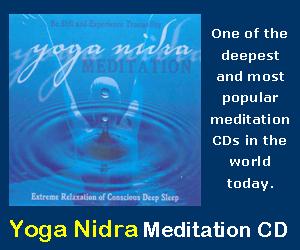|
|
Yoga
Nidra Method #5
by
Swami Jnaneshvara Bharati
SwamiJ.com
Back
to Yoga Nidra page Back to
"Methods" on Yoga Nidra page
|
|
| Yoga
Nidra Method #5
|
|
First, do Navel
center practice |
- Lie on your back, in
shavasana, the corpse posture. Lie in such a way that your
spine is aligned, and your feet and arms are a comfortable
distance to your sides. It is best to have a thin pillow
under your head and a shawl or blanket over your body so you
do not become cold. Systematically move your attention
through each of the points below.
- Bring your attention to the navel
center, and notice the motion of the abdomen and
diaphragm area. Notice the physical rise and fall of the
abdomen.
- Stay with that breath
awareness for some time, being mindful that the breath is
smooth, with no jerks, no pauses between breaths, that it is
quiet, and that the speed is just the right degree of slow.
- After some time, allow the
exhalation to elongate to a 2-to-1 ratio, where the
exhalation is twice as long as the inhalation.
- Stay with this breath
awareness for some time, and then, when it feels right,
transition to the spinal breath.
- Allow the breath to become
ever slower and slower, but in a natural, gentle way,
keeping the mind focused on the practice.
- Exhale as though you are
breathing from the top of the head down to the perineum at
the base of the spine.
- Inhale as though you are
breathing from the perineum at the base of the spine, up to
the top of the head.
- Exhale and inhale many times
in this way, exhaling down and inhaling up.
- Imagine that the breath is
flowing in a thin, milky white stream from top to bottom,
and bottom to top. It does not matter whether or not you
literally see the stream with your inner eye, but know that
this stream of energy is actually there in the subtle body,
and will someday be experienced directly.
|
|
Next, do Spinal
breath practice |
- Exhale as though you are
breathing from the top of the head down to the perineum at
the base of the spine.
- Inhale as though you are
breathing from the perineum at the base of the spine, up to
the top of the head.
- Exhale and inhale many times
in this way, exhaling down and inhaling up.
- Imagine that the breath is
flowing in a thin, milky white stream from top to bottom,
and bottom to top. It does not matter whether or not you
literally see the stream with your inner eye, but know that
this stream of energy is actually there in the subtle body,
and will someday be experienced directly.
|
|
Next, enter into
Yoga Nidra in the heart
|
- Bring your attention to the
space between the breasts, the heart center, and allow your
awareness to empty completely of any images, impressions,
thoughts, sensations, or other experiences. Just go deep
into the stillness and silence.
- Remain in that deep
stillness and silence for up to 10 minutes, but no more
initially. With practice, the length of time may lengthen
some, though this is not too important.
- After remaining in the
stillness and silence for some period, there will likely
come a moment when thoughts, impressions, or sensations
return. They may return smoothly and gradually, or there may
be a sudden jolt. When this happens, it is a natural sign
that this session of Yoga Nidra is completed.
- Systematically bring your
attention back outward from the stillness and silence,
through the awareness of the relative quietness of the mind,
the awareness of the smoothness of the breath, and this
stillness of the physical body.
- Bring the deep stillness and
silence with you, as you gently wiggle your fingers and
toes, then gradually move as you wish, and open your
eyes.
- After the Yoga Nidra, you
might quietly return to your daily activities, or take a few
minutes for meditation, contemplation, or prayer.
|

-------
This site is devoted to
presenting the ancient Self-Realization path of
the Tradition of the Himalayan masters in simple, understandable and
beneficial ways, while not compromising quality or depth. The goal of
our sadhana or practices is the highest
Joy that comes from the Realization in direct experience of the
center of consciousness, the Self, the Atman or Purusha, which is
one and the same with the Absolute Reality.
This Self-Realization comes through Yoga meditation of the Yoga
Sutras, the contemplative insight of Advaita Vedanta, and the
intense devotion of Samaya Sri Vidya Tantra, the three of which
complement one another like fingers on a hand.
We employ the classical approaches of Raja, Jnana, Karma, and Bhakti
Yoga, as well as Hatha, Kriya, Kundalini, Laya, Mantra, Nada, Siddha,
and Tantra Yoga. Meditation, contemplation, mantra and prayer
finally converge into a unified force directed towards the final
stage, piercing the pearl of wisdom called bindu, leading to the
Absolute.
|
|